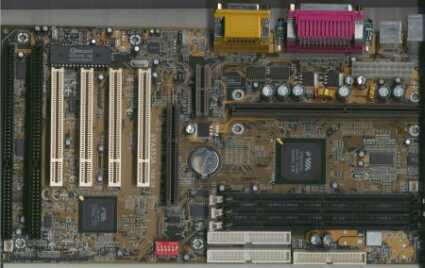21 Slot-1 Motherboards using VIA Chipsets
Lucky Star 6VA693A
Board Revision: 3.0
BIOS Version: D4 (September 22, 1999)
6VA693A already tells you which chipset has been used for this motherboard. The package contains the CPU retention parts, which have to be installed manually, an FDD and one 80-pin IDE cable and as with all other boards: driver CD and manual. Although the latter describes features and installation, most BIOS items are not explained.
You are given the option to change the multiplier (in case your CPU allows this) by the red DIPswitches. FSB is detected automatically. Of course you can chose another FSB: 66, 75, 83, 100, 103, 112, 124, 133, 140 or 150 MHz are your choices, which can be set using the first two switches of the DIP block.
Lucky Star equips their board with two ISA slots, four PCI slots, three DIMM sockets and the AMR slot. Thanks to the South Bridge VT82C686A, this platform does also include AC97 sound with the common line in, line out and microphone jackets as well as a game port. ECC is not supported, but two additional USB ports are instead. As usual, the required cable has to be obtained separately. Of course the board can wake on LAN or on modem ring.
All connectors are clearly labelled. I was quite surprised to see that there is a jumper, which has to be set for Coppermine CPUs (JPX2 to 2-3). Lucky Star provides three fan headers, which has still not become standard. As most of today's components become quite hot and therefore unstable, cooling is a topic, which shouldn't be underestimated.
The memory clock can be increased or lowered by 33 MHz, either to use a 133 MHz CPU with 100 MHz memories or vice versa. Of course you may abuse this feature for overclocking as well. Regarding performance, the Lucky Star 6VA693A is an average board. There's nothing to complain about this board, but nothing exceptional either.
Get Tom's Hardware's best news and in-depth reviews, straight to your inbox.

Patrick Schmid was the editor-in-chief for Tom's Hardware from 2005 to 2006. He wrote numerous articles on a wide range of hardware topics, including storage, CPUs, and system builds.
